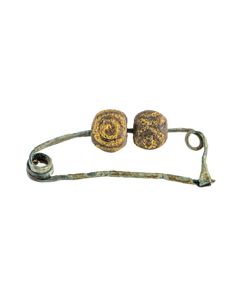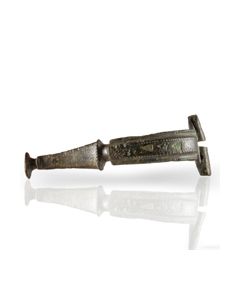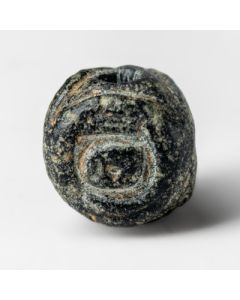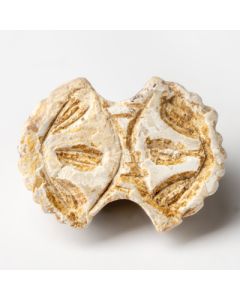Sold - Rare - Published objects
Published objects
Several works of art and artefacts that are or have been in our online gallery are published in literature. We often receive requests concerning published objects when more research or other publications on them are planned. Therefore we will give a list of published objects without this list being claimed to be exhaustive. If you are researching artefacts that have once been handled by our gallery or you would like to investigate an object still in our possession please do not hesitate to contact us. We will be glad to help.
-
 Viking stirrup mount
Viking stirrup mountOpenwork bronze plate from the 11th century. It was once attached to a horse harness strap. The beautiful decorations are typical of the art of the Vikings.
Price: on request Villanovan fibula from the Hattatt collection
Villanovan fibula from the Hattatt collectionBronze brooch of the Italic Iron Age. The piece is published in the standard work "Brooches of Antiquity".
Price: on request Villanovan fibula from the Hattatt collection
Villanovan fibula from the Hattatt collectionSerpentine bronze brooch of the Italic Iron Age. The piece is published in the standard work "Brooches of Antiquity".
Price: on request Large Villanovan fibula from the Hattatt collection
Large Villanovan fibula from the Hattatt collectionImposing bronze brooch of the Italic Iron Age. The piece is published in the standard work "Brooches of Antiquity".
Price: on request Early Italic brooch decorated with beads
Early Italic brooch decorated with beadsThere rare brooch type from northern Italy is based on predecessors from Greece. The piece is from the famous Richard Hattatt collection and is published in two of his works.
Price: on request Phrygian fibula from the Hattatt collection
Phrygian fibula from the Hattatt collectionBronze fibula from Anatolia around the time of King Midas. The piece is published in two standard works and was on loan to the Ashmolean Museum.
Price: on request Mesopotamian stamp seal in bull shape
Mesopotamian stamp seal in bull shapeThe magnificent seal is from the Jemdet Nasr period. The stamp shows quadrupeds and a scorpion. Published in a book about the Epstein collection.
Price: on request Egyptian painted panel with goddess Imentet
Egyptian painted panel with goddess ImentetThe painting was once on the inside of a sarcophagus lid, as a welcome to the underworld. The piece is published in an exhibition catalogue from 1972. From the 25th or 26th dynasty of Ancient Egypt.
Price: on request Predynastic hippopotamus amulet
Predynastic hippopotamus amuletWonderful figurine made of orange-red carnelian. Dating to the birth of Ancient Egypt. The rare piece was already scientifically studied in 1913.
Price: on request Published Greek figurine of a pantheress
Published Greek figurine of a pantheressThree-dimensional figurine with high level of detail, very nicely preserved. Around 300 BC, Magna Graecia. Published, from the Leo Mildenberg collection.
Price: on request Roman Hod Hill brooch from the Hattatt collection
Roman Hod Hill brooch from the Hattatt collectionNice and rare enameled variant of the Hod Hill type. Found in Norfolk, UK. The piece is published in two books by Richard Hattatt.
Price: on request Celtic penannular brooch
Celtic penannular broochPossibly made by the Celtic Durotriges tribe under Roman rule in Britain. The piece is published in two books by Richard Hattatt.
Price: on request Brooch from Roman Britain
Brooch from Roman BritainThis rare variant of the T-shaped brooches was found in Lechlade, Gloucestershire. It dates to the 1st or 2nd century AR. From the famous Hattatt collection and published in two standard works for ancient fibulae.
Price: on request Dolphin brooch from Roman Britain
Dolphin brooch from Roman BritainThe so-called dolphin brooch is very British. This specimen was probably made by the Celtic Corieltauvi tribe, shortly after the arrival of the Romans in the middle of the 1st century. Published in two works by Richard Hattatt.
Price: on request Celtic brooch from Iberia
Celtic brooch from IberiaThe early Celtic brooch dates from the 6th century BC and was found in Spain. This specimen is published in two standard works on ancient brooches.
Price: on request Flying bird brooch from Roman Britain
Flying bird brooch from Roman BritainA local British production from the 2nd century. It is taking up a continental brooch type. From the famous Hattatt collection and published in two standard works on ancient brooches.
Price: on request Roman rosette brooch from Colchester
Roman rosette brooch from ColchesterA nice brooch type from the 1st century with an especially well preserved decorative disc. From the famous Hattatt collection and published in two standard works on ancient brooches.
Price: on request Disc brooch from Roman Britain
Disc brooch from Roman BritainNicely enameled brooch with a Romano-Celtic sunburst design. From the 2nd century AD. Published in two stardard works on ancient brooches by Richard Hattatt.
Price: on request Trumpet brooch with Celtic decorations
Trumpet brooch with Celtic decorationsUnusual and rare variant of high importance, published several times. Beautiful silver inlays on the bow showing tendrils in Celtic style. From the 1st century.
Price: on request Roman Kraeftig Profilierte fibula
Roman Kraeftig Profilierte fibulaFibula with noble green patina. An import from mainland Europe to Roman Britain. From the 1st century AD. Published in two stardard works on ancient brooches by Richard Hattatt.
Price: on request Roman plate brooch
Roman plate broochOval bronze brooch with a setting for a glass insert. From the Roman imperial period. Published in two stardard works on ancient brooches by Richard Hattatt.
Price: on request Roman crossbow brooch
Roman crossbow broochVery nice specimen with niello inlays and remains of the original gilding. From the mid 4th century AD. Published in two stardard works on ancient fibulae.
Price: on request Etruscan scarab with athletes
Etruscan scarab with athletesMiniature work of art of the highest quality, a flagship of late Etruscan glyptics. Made of shimmering orange carnelian. Published several times and with provenance dating back to the 19th century.
Price: on request Roman headstud brooch
Roman headstud broochInteresting fibula with a covered hinge mechanism and enamel decoration on the bow. From the 2nd century Roman Britain. Published in two stardard works on ancient brooches by Richard Hattatt.
Price: on request Roman knee brooch from Britannia
Roman knee brooch from BritanniaWell preserved example of this important fibula type that was introduced to Britain by Roman troop movements from the Rhineland. This specimen was already produced locally in Britannia province. It was published in two books on ancient fibulae.
Price: on request Etruscan scarab with Prometheus
Etruscan scarab with PrometheusThe highest quality work of miniature art shows how Prometheus has just formed the first human from clay. A showpiece of late Etruscan glyptics made of beautiful carnelian.
Price: on request Roman seal box with phallus
Roman seal box with phallusCircular body with protective phallus in high relief on the lid. A piece from the Roman Imperial period, found in North East England. Published in a standard work by Richard Hattatt.
Price: on request Roman seal box
Roman seal boxPiriform body with engraved bird on the lid. A piece from the Roman Imperial period, found near Dover. Published in a standard work by Richard Hattatt.
Price: on request Enameled disc brooch from Britain
Enameled disc brooch from BritainColourful enameled brooch from the Roman Imperial period. Published in two stardard works on ancient brooches by Richard Hattatt.
Price: on request Roman Colchester type brooch
Roman Colchester type broochRare variant of this brooch type, found in Great Britain and dating to the mid 1st century AD. The piece is published twice in the famous Hattatt reference books on ancient fibulae.
Price: on request Roman seal box
Roman seal boxPiriform body with engraved cross on the lid. A piece from the Roman Imperial period. Published in a standard work by Richard Hattatt.
Price: on request Roman Celtic seal box
Roman Celtic seal boxLozenge shaped body with lid in Celtic design. A piece from the 1st or 2nd century, found near the Celtic settlement and later Roman town of Lindum. Published in a standard work by Richard Hattatt.
Price: on request Minoan seal from the Palace Period
Minoan seal from the Palace PeriodA beautiful serpentine seal with three engraved surfaces, worn like a bead. It dates from the Old Palace Period of Crete, around 1800 BC. The piece has been studied and published in the canonical Corpus of Minoan and Mycenaean seals in 1988.
Price: on request Minoan shell-shaped seal
Minoan shell-shaped sealAn early seal from Bronze Age Crete. The stamp surface is shaped like a shield and features floral decoration. The piece has been studied and published in the canonical Corpus of Minoan and Mycenaean seals in 1988.
Price: on request Roman bronze oil lamp - found in the UK
Roman bronze oil lamp - found in the UKFund aus der Ostenglischen Grafschaft Norfolk. Dokumentiert im Rahmen der PAS (Portable Antiques Scheme). Museale Erhaltung mit edler Patina.
Price: on request Ancient coin forger's lead form - found in Nothamptonshire, UK
Ancient coin forger's lead form - found in Nothamptonshire, UKGefunden in Pitchley, UK, am 1. Januar 2008. Der Fund ist mit PAS Nummer dokumentiert und wissenschaftlich untersucht. Von außerordentlicher Seltenheit.
Price: on request

